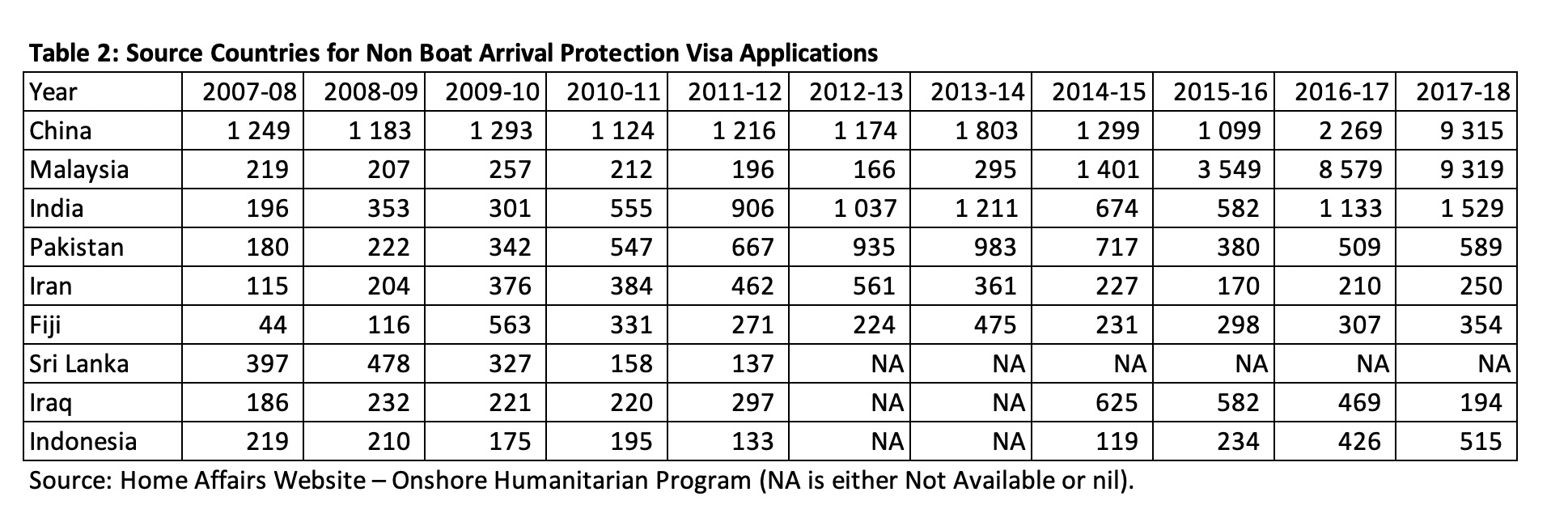Why did 50,000 asylum seekers arriving by boat represent a crisis for our border sovereignty while the arrival of a similar number over the past two and a half years by plane is just ho hum? Peter Dutton in 2017-18 has set a new record for the number of asylum seeker applications received. His record surpasses that set in 2012-13 under the Rudd/Gillard government. This is the result of a crisis in our visa processing system (see here) which is likely to be creating a honeypot for people smugglers. The new record will likely be exceeded in 2018-19 as Home Affairs is reducing frontline staff and IT contractors (see here). Outsourcing visa processing will make the problem worse. Tackling the chaos in our visa processing system will cost the taxpayer hundreds of millions of dollars, possibly north of a billion dollars and take many years. Is the Government’s border protection mantra a diversion from its real border protection failings? (Note: Please print this post to obtain a clearer view of the tables)
At 27,931, the number of onshore protection visa (ie asylum) applications lodged in 2017-18 exceeded the previous record of 26,845 in 2012-13 (see Table 1). The 2012-13 record included protection visa applications lodged by boat arrivals as well as by non-boat arrivals. Coincidentally, the number of protection visa applications in 2017-18 is around the same level as Dutton’s cut in the 2017-18 migration program.

The Home Affairs Annual Report says a large portion of these applications are ‘unmeritorious’. The increase in protection visa applications in the last two years has been driven largely by citizens from China, Malaysia and India (see Table 2). Vietnam has also recently emerged as a major source of protection visa applicants with 867 applications in 2016-17 and 764 applications in 2017-18.
The approval rate for protection visa applications from these countries is very low (eg around 2% for citizens of Malaysia) compared to very high rates of approval for protection visa applicants from countries such as Syria.
‘Unmeritorious’ protection visa applications undermine Australia’s arrangements for protecting people who genuinely need our help. But the current crisis in our visa processing system (see here) is creating a honeypot for people smugglers to take advantage of us.
Such a surge in ‘unmeritorious’ protection visa applications does not occur by accident or by chance. It requires a significant degree of organisation as our visa system is complex as are our workplace laws. For such a large increase in ‘unmeritorious’ protection visa applications to occur, people smugglers need to understand the paralysis the Home Affairs Department has created in the visa system through massive application backlogs. But they must also:
- recruit potential low skill overseas workers by convincing them of the ‘attractive’ jobs they will get in Australia;
- get the workers through the Home Affairs’ visitor visa processes;
- past Australian airport liaison officers stationed at relevant airports (eg at Kuala Lumpur and Singapore);
- past Border Force officers at Australian airports;
- transport them to likely unscrupulous employers and ensure they collect their ongoing ‘commission’ from the workers and/or employers;
- lodge protection visa applications on behalf of the workers so they can work in Australia legally;
- appeal the negative protection visa decisions at the AAT so overall time in Australia is extended to possibly more than 2-3 years.

People smugglers bringing in vulnerable people to work on farms, sex shops, etc is not a new phenomenon. Experienced immigration officers have understood this risk for at least two decades. But the current Home Affairs Department has few experienced immigration officers left, with many having been driven out by the current leadership.
As with people smugglers bringing in people on boats, the key to minimising a surge in ‘unmeritorious’ protection visa applications is to minimise the value of the product people smugglers can sell.
This means firstly ensuring non-genuine visitors are refused a visa and/or are picked up at the airport prior to departing for Australia or on arrival at the border. In this regard, Home Affairs has a key performance indicator that aims to ensure “100 percent of non-citizens posing known risks to the Australian community are refused/cancelled before or at the border.”
In its 2017-18 Annual Report, Home Affairs makes the staggering claim that this measure was met. Given the record levels of visitors changing status after arrival and record levels of people making ‘unmeritorious’ protection visa applications, the Home Affairs claim is patently false.
Secondly, minimising the risk of people smuggling requires that backlogs are not allowed to develop and that protection visa applications from source countries with low grant rates are processed quickly. By quickly processing these applications and removing failed applicants, people smugglers have little chance of making a profit. While Home Affairs claims in its Annual Report there has been a marginal improvement in processing times for ‘unmeritorious’ protection visa applicants, it is abundantly clear from the rapidly increasing backlog that its efforts have been woefully inadequate.
Finally, Home Affairs must identify, investigate and prosecute the people smugglers who are likely to be organising these scams.
To fully address this problem will involve a very substantial cost to the Australian taxpayer. In the late 1990s, we used a ballpark estimate of the cost of dealing with each unsuccessful protection visa application at between $25,000 and $50,000. This included the cost of:
- processing the application at the primary level noting that protection visa applications are highly complex even if ‘unmeritorious’;
- processing the application at the appeal stage noting that these are dealt with by very highly paid AAT members;
- locating the applicants who have been refused (as they rarely attend any appeal hearing);
- once located, detaining the refused applicant while any outstanding matters are addressed (eg requests for ministerial intervention or judicial review); and
- removing the applicant to their country of citizenship – this may require extensive negotiations with officials of the relevant country, including to verify identity and travel documents.
The costs will be at the higher end if the applicants seek judicial review or if there are additional complexities associated with removal.
On this basis, the overall cost of dealing with this surge in applications will be in the hundreds of millions of dollars and possibly over a billion dollars depending on how long it takes to get on top of the problem. Given Home Affairs is cutting frontline staff (see here), the problem will get a lot worse before it gets better. Outsourcing visa processing, as proposed by Home Affairs, will not help as the private contractor’s primary motive will be profit rather than the integrity of Australia’s visa system.
Poor management of the visa system has serious human and financial consequences. It also undermines public confidence in our immigration program.
Abul Rizvi was a senior official in the Department of Immigration from the early 1990s to 2007 when he left as Deputy Secretary. He was awarded the Public Service Medal and the Centenary Medal for services to development and implementation of immigration policy, including in particular the reshaping of Australia’s intake to focus on skilled migration. He is currently doing a PhD on Australia’s immigration policies.
Abul Rizvi PhD was a senior official in the Department of Immigration from the early 1990s to 2007 when he left as Deputy Secretary. He was awarded the Public Service Medal and the Centenary Medal for services to development and implementation of immigration policy, including the reshaping of Australia’s intake to focus on skilled migration, slow Australia’s rate of population ageing and boost Australia’s international education and tourism industries.

Comments
4 responses to “ABUL RIZVI. Dutton Sets New Asylum Seeker Application Record”
As the author notes, an applicant gets 2-3 years in Australia and usually able to work legally, and all they do is sign an application form which has an agent has filled in with a pro forma claim for protection.
They are required to do nothing further and that is the weakness of the system.
They should be called to a screening interview and required to produce documents and make a sworn statement setting out their claims. Failure to do so, or the statement not potentially engaging our protection obligations should result in visa cancellation, and liability to detained and removed.
Most of the non-meritorious applicants, i.e. those from 2% success rate countries, will not attend.
Numbers will drop quickly and the path will dry up.
So much time and money is wasted in refugee assessment looking at claims which are nothing more than the musings of an agent, and have nothing at all to do with the applicants actual circumstances.
‘Why did 50,000 asylum seekers arriving by boat represent a crisis for our border sovereignty while the arrival of a similar number over the past two and a half years by plane…’
It’s a point that should be made more often. The key is background checks. Our security services never regarded asylum seeker boats as a security threat – so long as we could intercept them before they reached the continental mainland and then ensure thorough background checks. Arrivals by air who then just disappeared into the community were regarded as a greater potential threat. When the ALP Govt began releasing people who arrived by boat into the community without thorough background checks, they created a security threat where none had existed. The individuals who were responsible for that egregious decision have forfeited the right to ever again have a senior role in Govt.
there are a few things that could be changed to shorten processing times and to bring down costs
People who come on boats are not being smuggled, it’s a legal right to come by sea and seek asylum. What you describe here is good old fashioned human trafficking. And before anyone decides to call me a liar here are the court transcripts in our courts all stating that simply transporting refugees to authorities at their request is not people smuggling.
http://sievx.com/articles/sentences/dirlist.php